Natural disasters while travelling in Japan, how did you gather information? We surveyed foreign tourists.
This article was translated from Japanese to English using AI. Click here to view the original article (in Japanese).
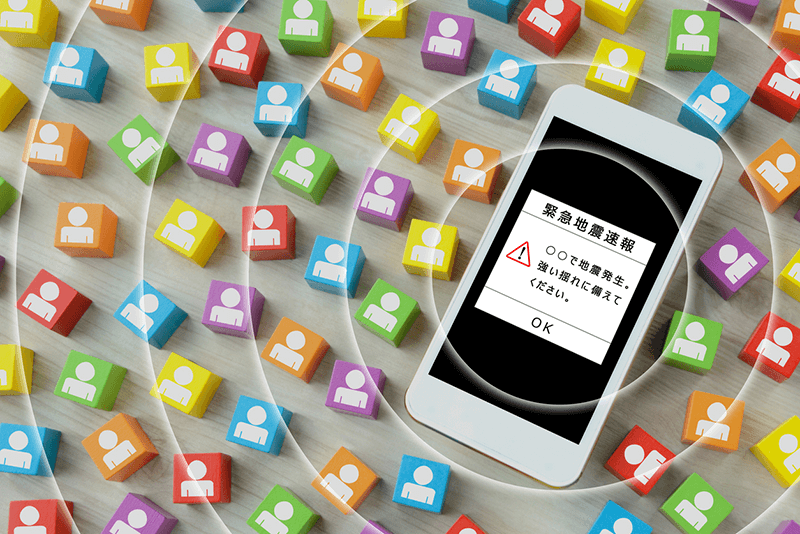
Japan is a country located on multiple tectonic plates, making it prone to earthquakes and volcanic activity. According to the Cabinet Office's Disaster Prevention page, natural disasters in Japan have intensified over the last 100 years.
Reference:令和5年版 防災白書|特集1 第2章 第1節 自然災害の激甚化・頻発化等 : 防災情報のページ - 内閣府
https://www.bousai.go.jp/kaigirep/hakusho/r05/honbun/t1_2s_01_00.html
Every year, torrential rains cause damage such as flooding and landslides. It's not uncommon for foreign tourists to experience natural disasters during their stay.
How do foreign visitors gather information in such situations?
In March 2024, NTTBP conducted a survey of Taiwanese and American tourists who had visited Japan, asking, "How did you gather information when you experienced a disaster while in Japan?" The survey was conducted online, with 393 Taiwanese and 102 Americans responding.
In this article, we will compare the communication awareness of respondents from each country, based on the survey results.
*Please contact NTTBP if you wish to reproduce the survey results in this article.
Respondent Attributes
Number of Visits to Japan
Most respondents were repeat visitors. Only 4% had visited Japan once, while 46% had visited more than 10 times. Compared to Japan National Tourist Organization (JNTO) statistics (https://statistics.jnto.go.jp/), this survey attracted more responses from frequent travelers, with a higher average number of visits from both Taiwanese and American respondents.
The most common stay length was around one week for Taiwanese respondents and two weeks for American respondents.
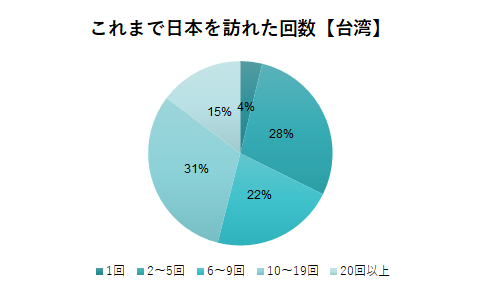
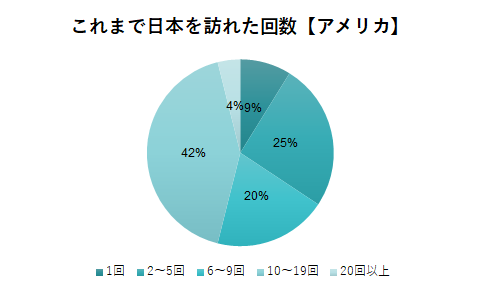
Number of Days Stayed
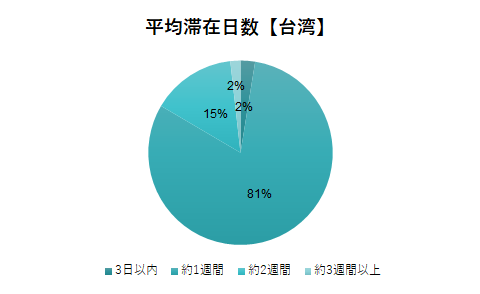

Have You Experienced a Disaster During Your Visit?
Due to the large number of repeat visitors among respondents, more than 30% from both Taiwan and the U.S. reported experiencing a disaster such as an earthquake, heavy rain, snow, or typhoon during their trip to Japan. This figure likely includes respondents who experienced minor earthquakes, but it is still a surprisingly high number.
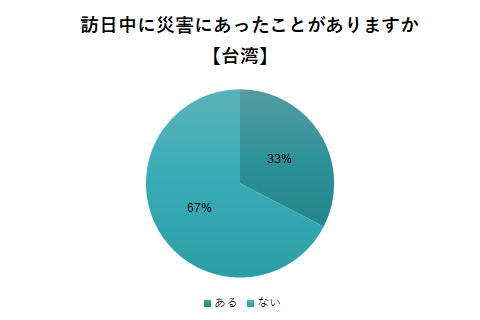
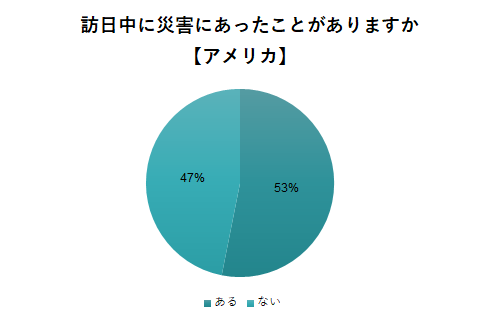
How to Gather Information During a Disaster
In both Taiwan and the U.S., the largest number of respondents said they gathered information through the internet, including websites and social media. Being connected to the internet is clearly crucial during a disaster.
In Taiwan, "gathering information via television" was a common response, whereas it was less so in the U.S. Some respondents also mentioned relying on accommodations and restaurants for information.
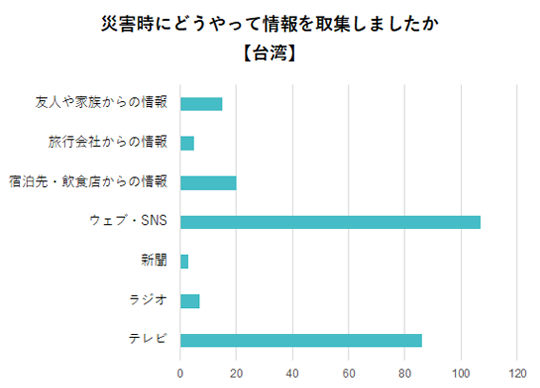
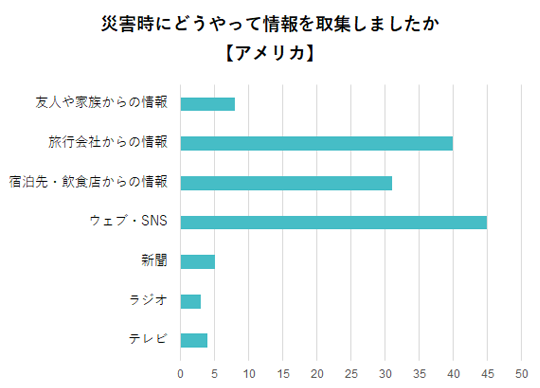
What Information Do You Want During a Disaster?
The survey results show that traffic information was the most sought-after in Taiwan, while evacuation center information was most desired in the U.S., suggesting that the demand for various types of information increases during disasters.
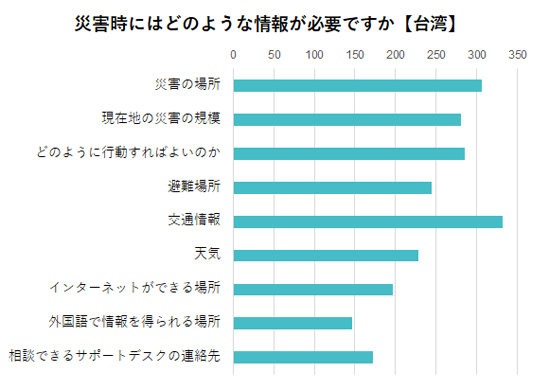
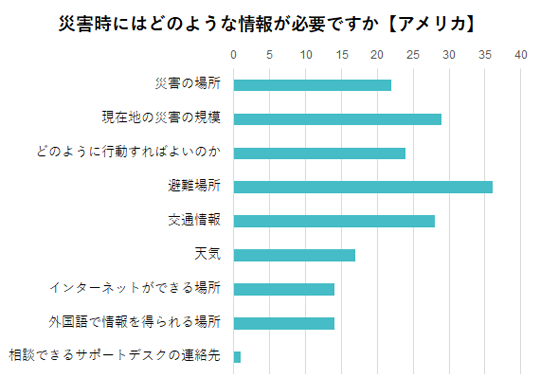
The survey also looked into useful websites during disasters, revealing that Google and other search engines, SNS platforms like Facebook, Instagram, and YouTube, and traffic information apps were frequently used.
Most people seem to rely on the services they typically use, rather than on disaster-specific apps or websites.
Recommended Websites for Foreign Visitors During Disasters
Many companies and local governments provide websites with disaster preparedness information. Below are some well-known websites you may find useful during a disaster.
Japan Tourism Agency
The Japan Tourism Agency has a website with tools useful during disasters.
訪日外国人観光者用災害時に役立つツール | 訪日外国人旅行者等の災害被害軽減 | 旅行者の安全の確保等 | 持続可能な観光地域づくり戦略 | 観光政策・制度 | 観光庁
https://www.mlit.go.jp/kankocho/seisaku_seido/kihonkeikaku/jizoku_kankochi/anzenkakuho/inbound/tool.html
One of the featured tools is the "Safety Tips" app, developed under the supervision of the Japan Tourism Agency. It offers disaster notifications and practical advice on preparedness.
NHK World JAPAN
NHK World JAPAN also provides valuable information in English. Along with disaster information, it covers topics like weather and heat stroke.
NHK World JAPAN
https://www3.nhk.or.jp/nhkworld/
SNS
Social networking sites can be useful for breaking news in emergencies. Following the Japan National Tourism Organization (JNTO) and the Cabinet Office Disaster Management X accounts can provide important updates, including posts in English during emergencies.
JNTO X Account
https://x.com/japansafetravel
Cabinet Office Disaster Management X Account
https://x.com/cao_bousai
Multiple Means of Communication During Emergencies
While preparing ways to gather information is important, ensuring that the communications infrastructure is robust is vital.
During severe disasters, mobile communication networks may become congested, making it difficult to connect. If you're only relying on a SIM card or mobile Wi-Fi, you might lose access to communication.
Free Wi-Fi can be a valuable resource. Many local governments and commercial facilities offer free Wi-Fi during disasters. Some public phones in Tokyo provide free Wi-Fi and are equipped with backup power in case of outages.
Refer to our previous article on free Wi-Fi usage during disasters.
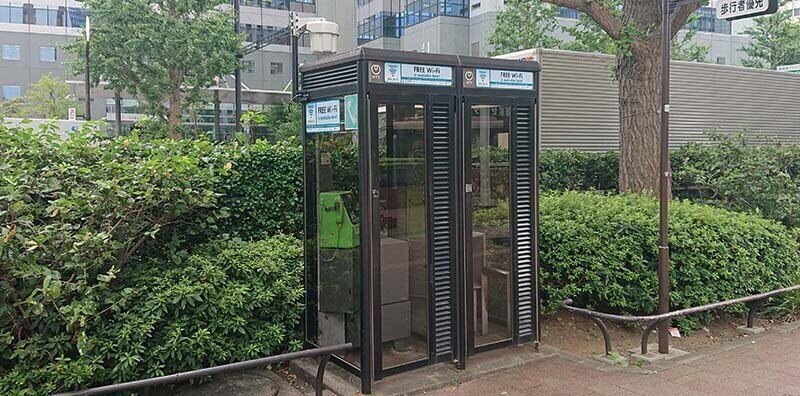
Please refer to our previous article on various precautions regarding free Wi-Fi in times of disaster.
Point Review! Let's properly understand the often misunderstood free Wi-Fi in times of disaster.
https://www.ntt-bp.net/column/en/blog/2024/02/post-150.html
In case of an emergency, being aware of the location of free Wi-Fi spots and knowing how to use them is also good preparation.
For example, it is recommended to install an app that shows the location of free Wi-Fi. Japan Wi-Fi auto-connect is a free Wi-Fi It is useful in an emergency. Simply install the app and complete a simple registration before your trip, and it will help you find Wi-Fi during your trip and in an emergency.
Related links: Japan Wi-Fi auto-connect | Free Wi-Fi auto-connect app
https://www.ntt-bp.net/jw-auto/
It is also advisable not to rely solely on the internet when travelling, but to obtain information through other means, such as television. And make sure you follow the instructions of your accommodation and the places you visit.
Tourist destinations and accommodation facilities have manuals on how to respond in the event of a natural disaster, as directed by the Tourism Agency. Follow the emergency response and evacuation plans that have been researched and prepared.
Conclusion
In this article, we compared how foreign visitors gather information during disasters. Whether you're a tourist or a business operating in Japan, it's essential to have a reliable method of communication in times of emergency.

